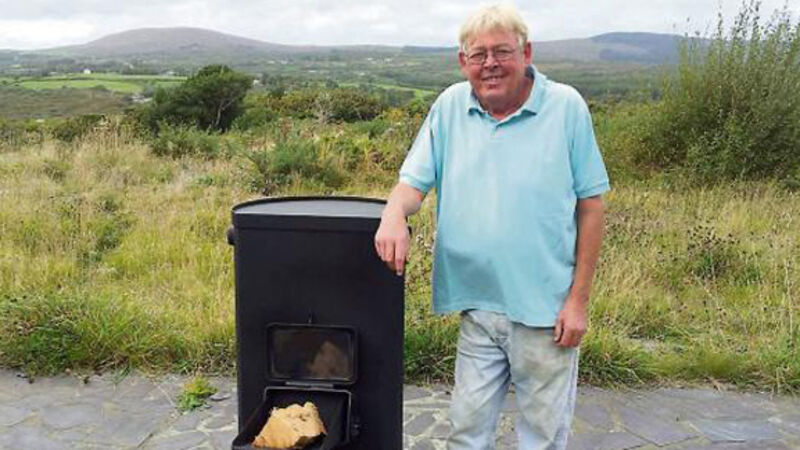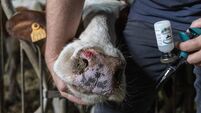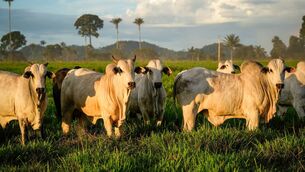Fanning the flames of healthy life choice

Many people today have some form of central heating, which can be programmed to warm the house for a while before it’s time to get up.
But many of us are also doing our best to conserve that heating oil or reduce the gas bill before the return of the good weather. And that means relying on the fire.
And in West Cork, where I am lucky enough to live, many of us have wood burning stoves which save a lot of heat from disappearing up the chimney, while still allowing you to see the reassuring flames of a real fire.
There’s also the added advantage of being able to boil a kettle or a pan of spuds on the woodburner once it gets a little heat going.
But there’s room for improvement, even within the efficient little wood burner, and one Ballydehob man has made remarkable strides in achieving this. More from John Fagan later.
For many people around the world, the fire is a vital means of cooking too. And this means that copious amounts of fuel have to be gathered. Cooking fuel has a huge impact on millions of lives and is one of the leading causes of death for women and small children.
HIV/Aids, maternal mortality all take their toll, but just as dangerous and much less well publicised is the risk of inhaling smoke from cooking on open fires in small, poorly ventilated rooms.
This leads to premature death from lung and heart diseases and according to the United Nations, this claims some 1.9m lives a year.
It is estimated that about 3bn people today live in homes where food is cooked on stoves or over fires which burn fuels such as wood, dung, charcoal or agricultural waste.
In poorly ventilated homes, the mix of chemicals such as carbon dioxide, methane and black carbon can reach 200 times the level that is considered safe to breathe. This kills twice as many people as malaria does.
Women and girls in the developing world may spend as much as 20 hours a week searching for fuel. And this is time that could be better spent going to school, running a business, or raising their families. If they live in an area of conflict, as fuel supplies dwindle this can take them further and further away from home and put them at daily risk of assault and rape.
Burning these fuels also contributes to climate change and causes natural habitats to dry up, forests to disappear and soil to erode.
This is a major challenge and has drawn a response from Hillary Clinton, who announced an initiative of $50m for research and production, and from the Global Alliance for Clean Cookstoves, a partnership led by the UN in order to produce more durable, affordable, and tailored stoves for the cooking needs of specific cultures. Their goal is for some 100m households to take up clean cookstoves by 2020.
John Fagan has spent more than three years researching, designing and developing a whole new generation of super efficient wood-burning eco stoves with high efficiency output rates and low carbon emissions. He told me how it all came about.
Well, it was as a result of something I heard on the Joe Duffy show about people who were so financially hard pressed that they couldn’t afford their central heating and they were going out picking up sticks to burn on their fires.
That got me thinking; I began working on my initial ideas, even though my wife thought I was losing the plot! But eventually, my Eireco Eco stove began to take shape.
No, not really. I’m originally from Dublin and I’d lived and worked in Germany for 26 years, teaching English and computer science.
But when we decided to return to Ireland, I knew I wanted to live in West Cork. I’d always holidayed here and I loved the place.
And like many other people who live here, I wanted to be as self-sufficient as possible. We grow our own vegetables, as well as grapes and lemons, and we make our own wine and beer.
People who live here generally do become very resourceful. I’m also a bit of a perfectionist, and I’ve usually got some new project on the go.
I did a lot of drawings, but I must say I didn’t realise how complicated it was going to be.
I had a full, professional package together and I got great help from the Enterprise Board who supplied me with a mentor and a grant. So I packed my stove up in the back of my little Mazda and headed for the ferry,because testing has to be done in the UK.
I don’t think they could believe their eyes when I showed up, but the results were extraordinary. The stove tested to possessing a 7.4 KW output, an efficiency rate of 89.5%, and carbon emissions of 0.16 %. It took over a week to get the necessary EU certifications but I was delighted with the results.
The EirEco Stove uses residual heat, and heat loss through the flue is kept to a minimum. Once a fire is lit in the burn chamber, air is immediately drawn into the system through the firebox.
The end result is a cleaner, more efficient burning stove which uses up to 40% less fuel to produce larger amounts of heat. For efficiency and carbon emissions EirErco beats the competition hands down.
They have been used in artists’ studios, homes, and even in large greenhouses because of their high tech heating performance. Since last October we have been in production and will be on the market ready for winter of this year.
It’s been a lot of work but the results have been well worth all the effort.










